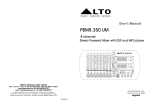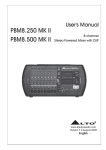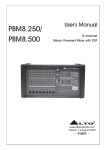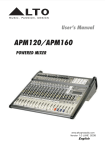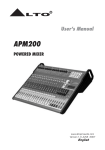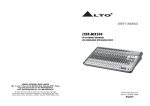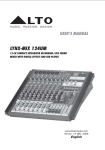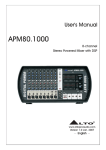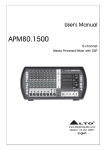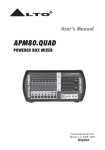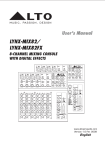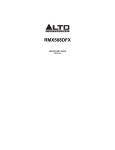Download Alto EQU MK II Series Owner`s manual
Transcript
R LTO OWNER'S MANUAL PBM8.250/8.500 MKII POWERED BOX MIXER www.altoproaudio.com Version 2.0 NOV. 2007 English CAUTION RISK OF ELECTRIC SHOCK DO NOT OPEN TO REDUCE THE RISK OF ELECTRIC SHOCK PLEASE DO NOT REMOVE THE COVER OR THE BACK PANEL OF THIS EQUIPMENT. THERE ARE NO PARTS NEEDED BY USER INSIDE THE EQUIPMENT. FOR SERVICE, PLEASE CONTACT QUALIFIED SERVICE CENTERS. WARNING To reduce the risk of electric shock and fire, do not expose this equipment to moisture or rain. Dispose of this product should not be placed in municipal waste and should be separate collection. 11. Move this Equipment only with a cart, stand, tripod, or bracket, This symbol, wherever used, alerts you to the specified by the presence of un-insulated and dangerous voltages manufacturer, or within the product enclosure. These are voltages that sold with the may be sufficient to constitute the risk of electric Equipment. When shock or death. a cart is used, use This symbol, wherever used, alerts you to caution when important operating and maintenance instructions. moving the cart / Please read. equipment Protective Ground Terminal combination to AC mains (Alternating Current) avoid possible Hazardous Live Terminal injury from tip-over. ON: Denotes the product is turned on. 12. Permanent hearing loss may be caused by OFF: Denotes the product is turned off. exposure to \ extremely high noise levels. CAUTION The US. Government's Occupational Safety Describes precautions that should be observed to and Health Administration (OSHA) has prevent damage to the product. specified the permissible exposure to noise 1. Read this Manual carefully before operation. level. 2. Keep this Manual in a safe place. These are shown in the following chart: 3. Be aware of all warnings reported with this symbol. HOURS X DAY SPL EXAMPLE 4. Keep this Equipment away from water and 90 Small gig 8 moisture. 92 train 6 5. Clean it only with dry cloth. Do not use 95 Subway train 4 solvent or other chemicals. 97 High level desktop monitors 3 6. Do not damp or cover any cooling opening. 100 Classic music concert 2 Install the equipment only in accordance with the Manufacturer's instructions. 102 1,5 105 1 7. Power Cords are designed for your safety. Do 110 0,5 not remove Ground connections! If the plug does not fit your AC outlet, seek advice from 0,25 or less 115 Rock concert a qualified electrician. Protect the power According to OSHA, an exposure to high SPL in cord and plug from any physical stress to excess of these limits may result in the loss of avoid risk of electric shock. Do not place heat. To avoid the potential damage of heat, it is heavy objects on the power cord. This could cause electric shock or fire. recommended that Personnel exposed to equipment capable of generating high SPL use 8. Unplug this equipment when unused for long hearing protection while such equipment is periods of time or during a storm. under operation. 9. Refer all service to qualified service personnel The apparatus shall be connected to a mains only. Do not perform any servicing other than those instructions contained within the socket outlet with a protective earthing User's Manual. connection. 10. To prevent fire and damage to the product, use only the recommended fuse type as indicated in this manual. Do not short-circuit the fuse holder. Before replacing the fuse, make sure that the product is OFF and disconnected from the AC outlet. The mains plug or an appliance coupler is used as the disconnect device, the disconnect device shall remain readily operable. IN THIS MANUAL: 1. 2. 3. 4. 5. 6. 7. 8. 9. INTRODUCTION................................................................................1 FEATURES.......................................................................................1 QUICK START..................................................................................4 CONTROL ELEMENTS......................................................................5 INSTALLATION & CONNECTION......................................................12 PRESET LIST.................................................................................16 BLOCK DIAGRAM..........................................................................17 TECHNICAL SPECIFICATIONS...........................................................18 WARRANTY..................................................................................20 1. INTRODUCTION Thank you for purchasing the LTO PBM8 8 channel powered mixer with 24-bit digital multi-effect built-in. It is just one of the many LTO products that a talented, multinational Team of Audio Engineers and Musicians have developed with their great passion for music. Your PBM8 is a remarkable compact powered mixer that doesn't find many equals in the market today. With 6 microphone and 2 stereo MIC/Line-level inputs for serious live performances, your PBM8 also includes a 24 Bit digital multi-effect with 16 Factory Presets and 16 variations for every preset, for a total of 256 different digital effects. There is a three bands EQ on all input channels and separate Master EQ for Main Mix and Monitor Outputs. Use it for small Gigs, for Church applications and for Conference. Enjoy your PBM8 and make sure to read this Manual carefully before operation! 2. FEATURES 6 MIC/Line input channels with gold plated XLR and balanced Line inputs 2 Stereo input channels with balanced TRS jacks Ultra-low noise discrete MIC preamps with +48V phantom power Extremely high headroom offering more dynamic range Each input channel with -20 dB PAD, PAN and level control 3-band equalizer on input channels 2 AUX sends for built-in or external effects, on-stage monitor mix, or headphone mixing Built-in feedback terminator 9-band graphic EQ for MAIN/MONITOR 256 position multi-effect 2-track recording IN/OUT (PHONO) Headphone output Stereo Line-level output 2 250 watt RMS amplifiers (For PBM8.250 MKII) 2 500 watt RMS amplifiers (For PBM8.500 MKII) Output connector: 6.3 jack + 4 way-speakon 1 IG HT DSP -20 dB PAD -20 dB PAD -20 dB PAD -20 dB PAD -20 dB PAD -20 dB PAD -20 dB PAD -20 dB PAD 1 16 0dB 0dB 0dB HIGH 0dB HIGH 0dB HIGH 0dB HIGH 0dB HIGH 2 3 4 5 13 0dB HIGH HIGH HIGH 6 12 10 12KHz +15dB 12KHz +15dB -15dB 0dB 12KHz +15dB -15dB 0dB 12KHz +15dB -15dB 0dB MID 12KHz +15dB -15dB 0dB MID 12KHz +15dB -15dB 0dB MID 12KHz +15dB -15dB 0dB MID 12KHz 0dB MID MID CLIP DSP MUTE +15dB -15dB 0dB MID 8 9 MUTE MID VARIATIONS 1 16 2.5KHz -15dB +15dB 0dB 2.5KHz -15dB +15dB 0dB 2.5KHz -15dB +15dB 0dB LOW 2.5KHz -15dB +15dB 0dB LOW 2.5KHz -15dB +15dB 0dB LOW 2.5KHz -15dB +15dB 0dB LOW 2.5KHz -15dB +15dB 0dB LOW +15dB LOW LOW 4 5 6 12 7 11 10 0 dB 0 dB 0 dB PAN 0 dB 0 dB 15 15 PAN Left Right 0 dB 50 DSP 8 8 +10dB 8 - PAN Left Right DSP/FX AUX2 POST +10dB 8 - MONITOR 0 dB 100 250 500 1K 2K5 5K 8K 16K FEEDBACK TERMINATOR +10dB 1. VOCAL 1 2. VOCAL 2 3. LARGE HALL 4. SMALL HALL 5. LARGE ROOM 6. SMALL ROOM 7. PLATE 8. TAPE REVERB 9. SPRING REVERB 10. MONO DELAY 11. STEREO DELAY 12. FLANGER 13. CHORUS 14. REVERB + DELAY 15. REVERB + FLANGER 16. REVERB + CHORUS 10 15 15 9 9 0 0 0 10 9 9 0 dB 0 dB 15 15 MAIN 0 dB LINE IN (bal.) - 50 100 250 R LOW NOISE P RE A LOW NOISE P RE A (MONO) (MONO) L L RE A 2 P 1 5K 8K 16K FEEDBACK TERMINATOR STEREO RTN M 2 P 1 LOW NOISE P RE A M 2 P 1 LOW NOISE P RE A M 2 P 1 LOW NOISE P M P 2 RE A M P 1 LOW NOISE P RE A M P P 2 LOW NOISE P RE A M M 1 2K5 FOOT SW. PHANTOM 48V TAPE TO CH9-10 OFF 1 2 AMPLIFIER MODE ON MAIN TAPE 2 1K +10dB LEVEL CH 9-10 R AUX2 OUT LOW NOISE P 500 +10dB 8 - +10dB 8 LEVEL CH 7-8 CH 6 LINE IN (bal.) - +10dB 8 LEVEL CH 5 LINE IN (bal.) - +10dB 8 LEVEL CH 4 LINE IN (bal.) - +10dB 8 LEVEL CH 3 LINE IN (bal.) - +10dB 8 LEVEL CH 2 LINE IN (bal.) - +10dB 8 8 8 - +10dB LEVEL CH 1 LEVEL 30 Right TO MAIN - +10dB LEVEL +10dB PRESETS: DSP - LEVEL 30 TO MON - +10dB 0dB AUX2 POST +10dB Left Right 8 8 8 8 8 8 0 dB Left Right - PAN 10 AUX1 PRE - DSP/FX AUX2 POST +10dB PAN Left Right - +10dB PAN Left Right - +10dB PAN Left Right 8 8 8 PAN Left - +10dB 8 - +10dB 8 - 0 0 9 MON +10dB 0dB DSP/FX AUX2 POST +15dB AUX1 PRE - +10dB 0dB DSP/FX AUX2 POST 10 9 0 9 0dB MON AUX1 PRE - +10dB 0dB DSP/FX AUX2 POST 8 9 80Hz -15dB +15dB 0dB MON AUX1 PRE - +10dB 0dB DSP/FX AUX2 POST 80Hz -15dB +15dB 0dB MON AUX1 PRE - +10dB 0dB DSP/FX AUX2 POST 80Hz -15dB +15dB 0dB MON AUX1 PRE - +10dB 0dB DSP/FX 80Hz -15dB +15dB 0dB MON AUX1 PRE - +10dB 0dB 80Hz -15dB +15dB 0dB MON AUX1 PRE - 80Hz -15dB +15dB 0dB MON 8 80Hz -15dB +15dB 0dB 8 80Hz -15dB 15 9 3 14 13 0dB LOW 15 2 15 2.5KHz -15dB OPERATING 7 11 -15dB PBM8.250 R LTO PRESETS 15 14 8 OT L 8 SP MONITOR OUT MAIN MAIN BRIDGE + + MAIN MONITOR HEADPHONE OUT MAIN OUT LEFT 1 3 3 3 3 3 3 3 3 MIC IN (bal.) MIC IN (bal.) MIC IN (bal.) MIC IN (bal.) MIC IN (bal.) MIC IN (bal.) MIC IN (bal.) MIC IN (bal.) RIGHT LEFT IN RIGHT OUT PMB8.250 MKII DSP -20 dB PAD -20 dB PAD -20 dB PAD -20 dB PAD -20 dB PAD -20 dB PAD 0dB 0dB 0dB 0dB 0dB 0dB 0dB R LTO PRESETS 16 1 2 15 3 11 7 HIGH HIGH HIGH HIGH HIGH HIGH HIGH HIGH 5 6 12 10 12KHz +15dB -15dB 12KHz +15dB -15dB 0dB 12KHz +15dB -15dB 0dB 12KHz +15dB -15dB 0dB MID 12KHz +15dB -15dB 0dB MID 12KHz +15dB -15dB 0dB MID 12KHz 2.5KHz -15dB +15dB +15dB -15dB 0dB MID 2.5KHz -15dB +15dB 0dB 0dB MID LOW 2.5KHz -15dB +15dB 0dB MID LOW 2.5KHz -15dB +15dB 0dB LOW 0dB LOW 2.5KHz -15dB +15dB 0dB LOW +15dB MUTE VARIATIONS LOW LOW 11 7 4 5 6 12 -15dB +15dB 0dB -15dB +15dB 0dB MON MON MON MON AUX1 PRE AUX1 PRE AUX1 PRE AUX1 PRE AUX1 PRE 0 dB Left Right 0 dB 0 dB 8 8 +10dB 8 - PAN Left Right AUX2 POST +10dB PAN Left Right 8 8 8 0 dB - 0 dB 9 15 15 PAN Left Right 0 dB 50 100 250 500 1K 2K5 5K 8K MONITOR 0 dB FEEDBACK TERMINATOR +10dB 1. VOCAL 1 2. VOCAL 2 3. LARGE HALL 4. SMALL HALL 5. LARGE ROOM 6. SMALL ROOM 7. PLATE 8. TAPE REVERB 9. SPRING REVERB 10. MONO DELAY 11. STEREO DELAY 12. FLANGER 13. CHORUS 14. REVERB + DELAY 15. REVERB + FLANGER 16. REVERB + CHORUS 15 15 9 10 9 0 0 0 10 9 9 15 15 0 dB 0 dB - 50 LEVEL LEVEL LEVEL LEVEL LEVEL LEVEL CH 2 CH 3 CH 4 CH 5 CH 6 LINE IN (bal.) LINE IN (bal.) LINE IN (bal.) LINE IN (bal.) LINE IN (bal.) LINE IN (bal.) 8 - +10dB 8 - +10dB 8 - +10dB 8 - +10dB 8 - +10dB 8 - +10dB 8 8 - +10dB 8 - +10dB CH 1 100 CH 9-10 R (MONO) (MONO) L L 2 1 P 1 RE A M 2 P 1 LOW NOISE P RE A M 2 P 1 LOW NOISE P RE A M 2 P 1 LOW NOISE P RE A M 2 P 1 LOW NOISE P RE A M 2 P P P 1 LOW NOISE P RE A M M M 2 LOW NOISE P RE A 2K5 5K 8K +10dB 16K FEEDBACK TERMINATOR FOOT SW. PHANTOM 48V TAPE TO CH9-10 OFF MAIN 2 STEREO RTN MONITOR OUT 1 3 3 3 3 3 3 3 3 MIC IN (bal.) MIC IN (bal.) MIC IN (bal.) MIC IN (bal.) MIC IN (bal.) MIC IN (bal.) MIC IN (bal.) MIC IN (bal.) RIGHT LEFT IN OUT ON AMPLIFIER MODE MAIN + MAIN MAIN BRIDGE + MONITOR HEADPHONE OUT MAIN OUT LEFT PMB8.500 MKII 2 1K +10dB TAPE LOW NOISE P RE A 500 LEVEL CH 7-8 R AUX2 OUT LOW NOISE P 250 LEVEL 30 Right 0 dB MAIN DSP LEVEL +10dB PRESETS: TO MAIN - LEVEL 30 16K TO MON - DSP/FX AUX2 POST +10dB PAN Left Right - +10dB 10 9 DSP +10dB 0dB DSP/FX AUX2 POST 8 - PAN - +10dB 0dB DSP/FX AUX2 POST +10dB PAN Left Right 8 8 8 Left 0 dB - +10dB - +10dB 0dB DSP/FX AUX2 POST 8 - PAN - +10dB 0dB DSP/FX AUX2 POST +10dB - +10dB 0dB DSP/FX AUX2 POST - - +10dB 0dB DSP/FX PAN Right - +10dB 0 0 - MON 0dB 8 +15dB AUX1 PRE - 9 0 0dB MON DSP/FX 9 15 9 80Hz AUX1 PRE 8 8 -15dB +15dB 0dB 80Hz MON +10dB Left 80Hz AUX1 PRE AUX2 POST - -15dB +15dB 0dB 8 0dB -15dB +15dB 0dB 80Hz MON +10dB 8 - -15dB +15dB 0dB 80Hz 8 -15dB +15dB 0dB 80Hz 8 -15dB 80Hz 10 15 2 3 10 80Hz 1 15 14 13 0dB LOW 8 CLIP MID 2.5KHz -15dB +15dB 0dB OPERATING DSP MUTE +15dB -15dB 0dB MID 2.5KHz -15dB +15dB 0dB 9 12KHz 16 2.5KHz -15dB PBM8.500 4 14 13 8 -20 dB PAD 8 -20 dB PAD 0dB RIGHT 3. QUICK START This is the fastest way to get something out from your PBM8, if you have a keyboard and a microphone. a. Plug the microphone into Channel 1 MIC IN. b. Turn down AUX and LEVEL controls on the input channel. c. Turn down MONITOR and MAIN master controls. d. Put the EQ controls on center position. e. Connect 2 passive cabinets to the rear speaker cabinets or 2 active cabinets to the front MAIN OUT connectors. f. Turn on your PBM8. g. Sing or speak into the microphone with normal volume and adjust the channel LEVEL control of half. h. If you like, you can add some equalization at this stage. i. Turn up the MAIN LEVEL control until you reach the desired volume. The +10 LED on the Master LED meter should flash only occasionally, otherwise you will hear the distortion. If this LED is not active and you still hear distortion, please turn down a little the input LEVEL control or reduce the output level of your source instrument. j. Connect your stereo keyboard into channel 7/8 and repeat the sequence. Here you are. It is your first gig with your PBM8. 3 HOOK SMALL CLUB UP DSP -20 dB PAD -20 dB PAD -20 dB PAD -20 dB PAD -20 dB PAD -20 dB PAD 0dB 0dB HIGH 0dB HIGH 0dB HIGH 0dB HIGH 16 1 2 10 9 8 3 4 5 13 0dB HIGH HIGH HIGH 6 12 12KHz +15dB 12KHz +15dB -15dB 0dB 12KHz +15dB -15dB 0dB 12KHz +15dB -15dB 0dB MID 12KHz +15dB -15dB 0dB MID 12KHz MID 12KHz +15dB -15dB 0dB +15dB -15dB 0dB MID 12KHz MID 0dB MID MID CLIP DSP MUTE +15dB -15dB 0dB MUTE MID VARIATIONS 16 1 2 10 9 8 2.5KHz -15dB +15dB 2.5KHz -15dB +15dB 0dB 2.5KHz -15dB +15dB 0dB 2.5KHz -15dB +15dB 0dB LOW 2.5KHz -15dB +15dB 0dB LOW 2.5KHz -15dB +15dB 0dB LOW 2.5KHz -15dB +15dB 0dB LOW +15dB 0dB LOW LOW LOW MIC3 5 7 AUX1 PRE AUX1 PRE AUX1 PRE AUX1 PRE AUX1 PRE AUX1 PRE AUX1 PRE AUX1 PRE 8 8 8 +10dB 8 8 8 8 8 8 8 8 AUX2 POST - +10dB PAN PAN Left Right PAN Left Right 0 dB 50 DSP - DSP/FX AUX2 POST - +10dB Left 0 dB 0 0 10 9 15 MONITOR 0 dB 100 250 500 1K 2K5 5K 8K FEEDBACK TERMINATOR +10dB PRESETS: 1. VOCAL 1 2. VOCAL 2 3. LARGE HALL 4. SMALL HALL 5. LARGE ROOM 6. SMALL ROOM 7. PLATE 8. TAPE REVERB 9. SPRING REVERB 10. MONO DELAY 11. STEREO DELAY 12. FLANGER 13. CHORUS 14. REVERB + DELAY 15. REVERB + FLANGER 16. REVERB + CHORUS 15 10 15 9 0 0 dB 0 dB 9 0 0 10 9 9 15 15 MAIN 0 dB CH 1 LEVEL CH 2 CH 3 LEVEL CH 4 CH 5 LEVEL - 50 LINE IN (bal.) LINE IN (bal.) LINE IN (bal.) LINE IN (bal.) LOW NOISE P LOW NOISE P LOW NOISE P LOW NOISE P 250 MIC IN (bal.) 2 MIC IN (bal.) P 1 1 3 2 8K +10dB 16K PHANTOM 48V TAPE TO CH9-10 AMPLIFIER MODE 3 MIC IN (bal.) ON OFF MAIN MONITOR OUT MAIN MAIN + + MAIN MONITOR BRIDGE HEADPHONE OUT MAIN OUT LEFT 1 3 MIC IN (bal.) STEREO RTN M MIC IN (bal.) 2 3 RIGHT LEFT IN MIC IN (bal.) RIGHT OUT D/I BOX D/I BOX WIRELESS MICROPHONE 1 P MIC IN (bal.) 2 3 RE A M 1 P MIC IN (bal.) 2 3 LOW NOISE P RE A M 1 P 2 3 LOW NOISE P RE A M 1 P 2 P P P 1 3 RE A M M M M 2 RE A 5K FOOT SW. L TAPE RE A 2K5 (MONO) AUX2 OUT RE A 1K R (MONO) L RE A 500 FEEDBACK TERMINATOR CH 9-10 R LINE IN (bal.) LOW NOISE P 100 +10dB LEVEL CH 7-8 CH 6 LINE IN (bal.) LOW NOISE P - +10dB 8 - +10dB 8 - +10dB LEVEL 8 - +10dB 8 - +10dB LEVEL 8 - +10dB 8 LEVEL 8 8 - +10dB 8 - +10dB LEVEL LEVEL 30 DSP TO MAIN - +10dB 16K Right 0 dB LEVEL 30 TO MON +10dB 0dB DSP/FX AUX2 POST - PAN Right 0 dB - +10dB 0dB DSP/FX AUX2 POST +10dB Left Right 0 dB - +10dB 0dB DSP/FX PAN Left Right - +10dB PAN Left - +10dB 0dB DSP/FX AUX2 POST - +10dB PAN 0 dB - +10dB 0dB DSP/FX AUX2 POST - +10dB Right 0 dB - +10dB 0dB DSP/FX AUX2 POST - Left Right - +10dB 0dB 8 - 9 9 15 - MON 8 8 +15dB 0dB MON DSP/FX 10 15 0 6 12 80Hz -15dB +15dB 0dB MON +10dB 8 80Hz -15dB +15dB 0dB MON PAN MIC1 MIC2 80Hz -15dB +15dB 0dB MON AUX2 POST - Left 80Hz -15dB +15dB 0dB MON +10dB 0dB 80Hz -15dB +15dB 0dB MON 8 - 80Hz -15dB +15dB 0dB MON 8 80Hz -15dB +15dB 0dB 9 4 14 13 0dB LOW 11 80Hz -15dB 15 3 15 2.5KHz -15dB OPERATING 7 11 -15dB PBM8.250 R LTO PRESETS 15 14 0dB 8 -20 dB PAD HIGH 8 -20 dB PAD 0dB CD PLAYER DRUM MACHINE STAGE MONITORS HOOK KEYBOARD BASS GUITAR GUITAR MAIN SPEAKERS COMPUTER SET-UP DIAGRAM UP DSP -20 dB PAD -20 dB PAD -20 dB PAD -20 dB PAD -20 dB PAD -20 dB PAD 0dB 0dB 0dB 0dB 0dB 16 1 2 10 9 8 3 4 5 13 0dB HIGH HIGH HIGH HIGH HIGH HIGH HIGH 12KHz 12KHz 12KHz 12KHz 12KHz 12KHz 12KHz 6 12 +15dB +15dB -15dB 0dB +15dB -15dB 0dB +15dB -15dB 0dB MID +15dB -15dB 0dB MID +15dB -15dB 0dB MID +15dB -15dB 0dB MID 0dB MID MID CLIP DSP MUTE +15dB -15dB 0dB MID MUTE MID VARIATIONS 16 1 2 10 9 8 15 2.5KHz -15dB 2.5KHz -15dB +15dB 2.5KHz -15dB +15dB 0dB 2.5KHz -15dB +15dB 0dB 2.5KHz -15dB +15dB 0dB LOW 2.5KHz -15dB +15dB 0dB LOW 2.5KHz -15dB +15dB 0dB LOW 0dB LOW 2.5KHz -15dB +15dB 0dB LOW +15dB LOW LOW 5 AUX1 PRE AUX1 PRE AUX1 PRE AUX1 PRE AUX1 PRE AUX1 PRE AUX1 PRE AUX1 PRE 8 8 8 +10dB 8 8 8 8 AUX2 POST - +10dB PAN PAN Left Right 0 dB PAN Left Right 0 dB 50 DSP - DSP/FX AUX2 POST - +10dB Left Right 0 dB 0 0 10 9 15 MONITOR 0 dB 100 250 500 1K 2K5 5K 8K +10dB PRESETS: 1. VOCAL 1 2. VOCAL 2 3. LARGE HALL 4. SMALL HALL 5. LARGE ROOM 6. SMALL ROOM 7. PLATE 8. TAPE REVERB 9. SPRING REVERB 10. MONO DELAY 11. STEREO DELAY 12. FLANGER 13. CHORUS 14. REVERB + DELAY 15. REVERB + FLANGER 16. REVERB + CHORUS 15 10 15 9 0 9 0 0 10 9 9 15 15 0 dB MAIN 0 dB CH 1 CH 2 CH 3 CH 4 LEVEL CH 5 - +10dB LEVEL - 50 CH 9-10 R LINE IN (bal.) LINE IN (bal.) LINE IN (bal.) LINE IN (bal.) LINE IN (bal.) LOW NOISE P LOW NOISE P LOW NOISE P LOW NOISE P LOW NOISE P 100 1 2 1 P 2 P 1 RE A M 2 P 1 LOW NOISE P RE A M 2 P 1 5K 8K +10dB 16K FOOT SW. L LOW NOISE P RE A M P 2 RE A M 1 P 2 M P P 1 M M M 2 RE A 2K5 PHANTOM 48V AMPLIFIER MODE (MONO) TAPE TO CH9-10 2 STEREO RTN ON OFF MAIN TAPE RE A 1K FEEDBACK TERMINATOR AUX2 OUT RE A 500 R (MONO) L RE A 250 +10dB LEVEL CH 7-8 CH 6 LINE IN (bal.) LOW NOISE P - +10dB 8 - +10dB 8 - +10dB LEVEL 8 - +10dB LEVEL 8 8 LEVEL 8 - +10dB 8 8 - +10dB LEVEL LEVEL 30 Right 0 dB DSP - +10dB LEVEL +10dB 16K FEEDBACK TERMINATOR TO MAIN - LEVEL 30 TO MON +10dB 0dB DSP/FX AUX2 POST - PAN 0 dB - +10dB 0dB DSP/FX AUX2 POST +10dB Left Right 8 8 8 8 8 8 8 8 0 dB - +10dB 0dB DSP/FX PAN Left Right - +10dB PAN Left - +10dB 0dB DSP/FX AUX2 POST - +10dB PAN Right 0 dB - +10dB 0dB DSP/FX AUX2 POST - +10dB Left 0 dB - +10dB 0dB DSP/FX AUX2 POST - +10dB Right - +10dB 0dB 9 9 15 - MON - 0 6 7 +15dB 0dB MON DSP/FX 10 15 9 4 12 80Hz -15dB +15dB 0dB MON 8 MIC3 80Hz -15dB +15dB 0dB MON PAN MIC1 MIC2 80Hz -15dB +15dB 0dB MON AUX2 POST - Left 80Hz -15dB +15dB 0dB MON +10dB 0dB 80Hz -15dB +15dB 0dB MON 8 - 80Hz -15dB +15dB 0dB MON 8 80Hz -15dB +15dB 0dB 15 3 14 13 0dB LOW 11 80Hz -15dB OPERATING 7 11 -15dB PBM8.250 R LTO PRESETS 15 14 0dB 8 -20 dB PAD HIGH 12KHz 8 -20 dB PAD 0dB MONITOR OUT MAIN + MAIN MAIN BRIDGE + MONITOR HEADPHONE OUT MAIN OUT LEFT 1 3 3 3 3 3 3 3 3 MIC IN (bal.) MIC IN (bal.) MIC IN (bal.) MIC IN (bal.) MIC IN (bal.) MIC IN (bal.) MIC IN (bal.) MIC IN (bal.) RIGHT LEFT IN RIGHT MAIN SPEAKERS OUT EQUALIZER R LTO MAC 2.4 Stereo Power Amplifier ON WIRELESS MICROPHONE D/I BOX D/I BOX CH1 POWER CH2 PROT CLIP SIG OFF POWER CD PLAYER POWER AMPLIFIER DRUM MACHINE GUITAR 4 BASS GUITAR KEYBOARD STAGE MONITORS ADDITIONAL SPEAKERS SP OT L IG 4. 3. CONTROL ELEMENTS HT 1 MIC/LINE MONO INPUT (1 to 6) Your PBM8 is equipped with 6 low-noise microphone preamplifiers with optional phantom power, 50 dB of Gain and over 90 dB of S/N ratio. You can connect almost any type of microphone. Dynamic microphones do not need phantom power. Use phantom power only with condenser microphones but make sure that the phantom power button is disengaged before connecting the microphone. Phantom power will not damage your dynamic microphones but it may damage tube or ribbon microphones. So make sure to read the microphone instructions manual before engaging phantom power. Use switch (19) to activate/deactivate phantom power. These 6 channels are also equipped with 1/4" TRS balanced/unbalanced LINE-IN plugs to connect line-level instruments such as keyboards, drum machines and effect devices. CH 7-8 CH 6 R LINE IN (bal.) (MONO) L LOW NOISE P LOW NOISE P RE A M M 1 3 3 MIC IN (bal.) MIC IN (bal.) 2 1 -20 dB PAD 10 NOTE: Never try to connect a line-level signal to the XLR MIC input when the phantom power is engaged, or you may seriously damage your equipment. 0dB HIGH 12KHz 2 MIC/LINE STEREO LINE INPUTS These are channels 7/8 and 9/10. They are organised in stereo pair and provided with XLR balanced socket and 1/4" TRS phone sockets. If you connect only the left jack, the input will operate in mono mode, that is the mono signal will appear on both input channels. You can use these inputs with a stereo keyboard, drum machine, etc. P P 2 1 2 RE A 9 +15dB -15dB 0dB MID 2.5KHz -15dB 8 +15dB 0dB LOW 80Hz -15dB 7 +15dB 0dB MON AUX1 PRE - 0dB DSP/FX AUX2 POST 5 +10dB 8 - PAN 4 Left Right 0 dB 3 - 8 4 PAN This is the PANORAMA control, or balance control. You can adjust the stereo image of the signal via this control. Keep this control in center position and your signal will be positioned in the middle of stage. Turn this control fully counter clockwise and the signal will be present only on the left speaker and vice-versa. Of course a large number of intermediate positions are available. 6 +10dB 8 3 LEVEL CONTROL This control is used to adjust the overall level of respective channel. The adjustable range goes from to +10 dB. +10dB LEVEL 5 SP OT L IG 4. 3. CONTROL ELEMENTS HT 5 DSP/FX The AUX2 control is configured as POST-FADER, so the audio signal will be affected by channel LEVEL control and sent to the resident digital multi-effect. Via the AUX2 OUT jack, the AUX2 signal can be sent to an external effects device, and in such case the resident digital multi-effects will be automatically disconnected. 6 MON/AUX1 Your PBM8 has two auxiliary sends which can be used for sending signals to external or internal effects devices or for creating a monitor mix. They are used to adjust the level of respective channel signal sent to AUX bus, and the adjustable range goes from - to +10 dB. The AUX1 control is configured as PRE-FADER, which means that the signal is sent out before reaching the channel fader. It is used to feed stage monitors in a live situation, or for a headphone mix in recording application. EQUALIZATION You have three EQ controls for each mono and stereo input channel each providing +/-15dB of boost and cut. The signal will be unaffected when the controls on the center position. You may use an external equalizer to make up a mix properly but a master equalizer will not have effect on a single channel and you may overload the signal easily. Individual EQ will give you a much better control on single tracks. 7 HI If you turn this control up, you will boost all the frequencies above 12kHz ( shelving filter ). You will add transparency to vocals and guitar and also make cymbals crispier. Turn the control down to cut all frequencies above 12kHz. In such way you can reduce sibilances of human voice or reduce the hiss of a Tape player. 8 MID This is a peaking filter and it will boost/cuts frequencies with their center at 2.5kHz. This control will affect especially upper male and lower female vocal ranges and also the harmonics of most musical instruments. 9 LOW If you turn this control up you will boost all frequencies below 80Hz. You will give more punch to bass drums and bass guitar; and you will make the male vocalist more "macho". Turn it down, and you will cut all the frequencies below 80Hz. In this way you can avoid low-frequency vibrations and resonance thus preserving the life of your woofers. 10 -20 dB PAD Pressing this button will attenuate the input signal by 20dB. In such way you can produce increased headroom and reduce the risk of distortion because of level peaks at input level when the input signal is quite hot. 6 SP OT L IG 4. 3. CONTROL ELEMENTS HT MASTER SECTION 18 OPERATING 15 15 10 9 9 0 0 0 10 9 9 13 0 dB LEVEL 30 15 - 50 100 250 500 1K 2K5 5K 8K +10dB 8 15 MONITOR 16K 11 FEEDBACK TERMINATOR 15 15 10 9 9 0 0 0 10 9 15 0 dB - 50 100 250 500 1K 2K5 5K 8K 17 LEVEL 30 16K FEEDBACK TERMINATOR 8 9 15 MAIN 15 12 +10dB 16 14 11 STEREO GRAPHIC EQ Your PBM8 is equipped with two graphic EQs with 9 adjustable bands each; one is for the MAIN MIX and the other for the MONITOR MIX. Via the faders, you can boost or cut the selected frequency by +/-15 dB at the indicated frequencies. When all faders are at the center position, the equalizer will do nothing. 12 FEEDBACK TERMINATOR Button (MONITOR MIX) Pressing this button the feedback detection function will be activated in the monitor signal path. Feedback will be identified at a certain frequency when the correspondent fader LED lights up. Feedback will produce an unpleasant speaker "howling" or "whistling". In this case, in order to eliminate feedback, you need to turn down the corresponding fader until feedback disappears. 13 MONITOR LEVEL LED DISPLAY This LED display will show you the monitor output level. Make sure that the +10 LED only lights up occasionally. The optimal level is when the -10 and 0 LED light up. If only the -30 LED lights up or even doesn't come to life your S/N ratio will be degraded. 14 FEEDBACK TERMINATOR Button (MAIN MIX) By pressing this button, the feedback detection function will be activated in the Main Mix signal path. Feedback will be identified at a certain frequency when the correspondent fader LED will light up. Feedback will produce an unpleasant speaker "howling" or "whistling". In this case, in order to eliminate feedback, you need to turn down the corresponding fader until feedback disappears. 7 SP OT L IG 4. 3. CONTROL ELEMENTS HT 15 MONITOR LEVEL CONTROL This control is used to adjust the level of the monitor output. 16 MAIN MIX LEVEL CONTROL This control is used to adjust the overall volume of the main mix output. 17 MAIN MIX LEVEL LED DISPLAY This LED display will show you the Main Mix output level. Make sure that the +10 LED only lights up occasionally. The optimal level is when the -10 and 0 LED light up. If only the -30 LED lights up or even doesn't come to life your S/N ratio will be degraded. 18 OPERATING LED DISPLAY The LED indicates when the power is switched on in your PBM8. 19 20 19 PHANTOM 48V SWITCH Activating this switch, you will apply +48V phantom power only to the 8 XLR microphone inputs and only to the XLR MIC sockets. Never plug in a microphone when phantom power is already on. Before turning phantom power on, make sure that all faders are all the way down. In this way, you will protect your stage monitors and main loudspeakers. 20 AMPLIFIER MODE SWITCH This switch provides three modes: MAIN/MAIN, MAIN/MONITOR and BRIDGE. Select any one of these modes to route the signals to the corresponding jacks according to the speaker connection at speaker jacks on the rear panel. You will find more details about the Amplifier Mode switch later on in this Manual. MASTER SECTION INPUT AND OUTPUT JACKS 24 26 AUX2 OUT MAIN OUT HEADPHONE OUT LEFT LEFT IN 8 MONITOR OUT MAIN RIGHT 25 22 TAPE TO CH9-10 TAPE STEREO RTN 21 RIGHT OUT 27 28 23 SP OT L IG 4. 3. CONTROL ELEMENTS HT 21 MONITOR OUT JACK Use this balanced MONITOR jack to connect the input of an external amplifier or active monitor speaker. 22 MAIN OUT JACKS These jacks are used to output the Main Mix signal to an external amplifier or active speaker. 23 HEADPHONE OUT JACK This is a stereo phone type output jack. It is used to send out the Main Mix signal to a pair of headphones. 24 AUX2 OUT JACK The phone jack is used to output the line level signal of the AUX2 post fader bus. You can use it to feed the inputs of a stereo multi-effects (you will need a Y-type cable ). 25 STEREO RETURN JACK Use this stereo phone jack to return the stereo signal of an effect unit into the Main Mix. You can also use it as the extra auxiliary input. 26 TAPE TO SELECT SWITCH If you position this switch to the left, you will route the signal fed into the TAPE IN sockets into CH9~10 path, and the signal will be affected by channel level control, channel EQ, DSP send, and MAIN level control, while positioning this switch to the right will route the TAPE IN signal into Main Mix bus. In this case, signal will be affected only by Main level control. 27 TAPE IN CONNECTORS Your PBM8 features dual RCA jacks for TAPE IN (left and right). Typically, these connectors are used to feed into the mixer the stereo signal from a CD Player, Tape or DAT Player, iPod, MP3 and so on. It is useful to use these inputs this way if you stop the GIG for a couple of beers or more. 28 TAPE OUT Your PBM8 also includes dual RCA jacks for stereo out (left and right). Via these jacks, you can route the Main Mix signal into a tape recorder or DAT for recording your session. 9 SP OT L IG 4. 3. CONTROL ELEMENTS HT DSP SECTION There is a powerful 24-bit/256 preset digital multi-effects included in your PBM8. Effects include reverbs, chorus, flanger, delay and combinations of the above. 29 PRESETS Control DSP This knob will select one of the 16 Factory Presets. PRESETS 16 30 DSP MUTE Button 1 2 3 15 4 14 This button is used to activate/deactivate the digital multi-effect. Alternatively, you can also use the DSP FOOTSWITCH for a faster operation. 5 13 6 12 7 11 10 9 CLIP 30 MUTE 31 8 DSP MUTE 31 PEAK LED This LED will flash when the signal input into the digital multi-effect is too strong. When the digital effect module is muted by the (30) button the LED also lights up. 29 VARIATIONS 16 1 2 3 15 4 14 5 13 6 12 32 7 11 10 9 8 32 VARIATIONS Control 33 DSP TO MON This control is used to control the volume of the processed signal sent to Monitor Mix, which can be varied from - to +10 dB. 34 DSP TO MAIN This control is used to control the volume of the processed signal sent to Main Mix bus, which can be varied from - to+10 dB. DSP - 8 TO MON 33 +10dB PRESETS: 1. VOCAL 1 2. VOCAL 2 3. LARGE HALL 4. SMALL HALL 5. LARGE ROOM 6. SMALL ROOM 7. PLATE 8. TAPE REVERB 9. SPRING REVERB 10. MONO DELAY 11. STEREO DELAY 12. FLANGER 13. CHORUS 14. REVERB + DELAY 15. REVERB + FLANGER 16. REVERB + CHORUS 0 dB DSP TO MAIN - 8 For each of the 16 Factory Presets you can apply up to 16 variations, so in total your PBM8 offers 256 different presets. If you want to know which Parameter is modified by this control, please look at the following chart. 34 +10dB FOOT SW. 35 35 DSP FOOTSWITCH Socket This 1/4" phone jack can be used to connect an external optional footswitch to turn on/off the onboard digital multi-effect. 10 SP OT L IG 4. 3. CONTROL ELEMENTS HT REAR PANEL R LTO POW ERED MIXER MODEL: PBM8.250 MK LEFT/MONO MAIN POW ER OUTPUT 2 1+ 1POS NEG 36 CAUTION RISK OF ELECTRIC SHOCK DO NOT OPEN MODEL WARNING: SHOCK HAZARD - DO NOT OPEN AVIS: RISQUE DE CHOC ELECTRIQUE - NE PAS OUVRIR SERIAL REPLACE WITH THE SAME TYPE FUSE AND RATING DISCONNECT SUPPLY CORD BEFORE CHANGING FUSE CAUTION: AC INPUT 100 VAC~60HZ 230 VAC~50HZ 120 VAC~60HZ 240 VAC~50HZ OUTPUT 2 OUTPUT 1 RIGHT/ MONITOR BRIDGE MODE STEREO MODE: OUTPUT 1 1+ 1POS NEG BRIDGE 2+ 1+ POS NEG 250 W @ 4 OHM 190 W @ 8 OHM BRIDGE MODE: 500 W @ 8 OHM Use only with a 250V fuse 37 (4 OHM MIN. LOAD) (8 OHM MIN. LOAD) OUTPUT 2 2+ 2POS NEG FUSE 250V T3.15AH CLASS 2 W IRING MAY BE USED Apparaten skall anslutas till jordat uttag nar den ansluts till ett natverk 38 36 POWER ON/OFF Switch This switch is used to turn the main power ON and OFF. 37 AC Inlet with FUSE Holder Use it to connect your PBM8 to the main AC with the supplied AC cord. Please check the voltage available in your country and how the voltage for your PBM8 is configured before attempting to connect your PBM8 to the main AC. 38 SPEAKERS Jacks These jacks are used to connect speakers. They are configured with 4-way speakon connectors and 1/4" phone jacks. You can determine the signal that is output to these jacks according to the setting of the AMPLIFIER MODE select switch, as we will describe in a moment. Note: In order to avoid damage to the built-in amplifier, please pay attention to the allowed impedance of the speaker. Very low load impedances may damage The amplifier. Look at this plate on your PBM8 for reference. STEREO MODE: 250 W @ 4 OHM 190 W @ 8 OHM STEREO MODE: (4 OHM MIN. LOAD) BRIDGE MODE: 500 W @ 8 OHM (8 OHM MIN. LOAD) CLASS 2 W IRING MAY BE USED PBM8.250 MKII 500 W @ 4 OHM 300 W @ 8 OHM (4 OHM MIN. LOAD) BRIDGE MODE: 1000 W @ 8 OHM (8 OHM MIN. LOAD) CLASS 2 W IRING MAY BE USED PBM8.500 MKII 11 5. INSTALLATION AND CONNECTION Ok, you have got to this point and you are now in the position to successfully operate your PBM8. However, we advise you to read carefully the following section to be the real master of your own mix. Not paying attention enough to the input signal level, to the routing of the signal and the assignment of the signal will result in unwanted distortion, a corrupted signal or no sound at all. So you should follow this procedure for every single channel: 1. Turn down all Input and output gain controls. 2. Connect phantom powered microphones before switching on the +48 V phantom power switch. 3. Set the output level of your PBM8 or the connected power amplifier at no more than 75%. 4. Now, set the MONITOR level at no more than 50%. In this way you will be able to hear later what you are doing connecting a pair of headphones or a pair of powered studio monitor speakers. 5. Position EQ controls on middle position. 6. Position panoramic (PAN) control on center position. 7. Increase the input gain properly for maintaining the good headroom and ideal dynamic range. 8. Depending on the actual application, turn slowly the input and output level controls for obtaining the maximum gain before distortion. 9. Now repeat the same sequence for all input channels. The main LED meter could move up into the red section. In this case you can adjust the overall output level through the MAIN MIX control. Audio Connections You can connect unbalanced equipment to balanced inputs and outputs. Simply follow these schematics. Sleeve Tip Ring Ring=Right Signal Strain Clamp Tip=Left Signal Sleeve=Ground/Screen Use for Headphone 1/4" Stereo (TRS) Jack Plug Sleeve Tip Tip=Signal Strain Clamp Sleeve=Ground/Screen Use for Mono Line In, Mono 1/4"Jack Plugs 1/4" Mono (TS) Jack Plug 12 5. INSTALLATION AND CONNECTION 3. CONTROL ELEMENTS Sleeve Ring=Return Signal Tip Ring Strain Clamp Tip=Send Signal Sleeve=Ground/Screen Use for Insert Points 1/4" Stereo (TRS) Jack Plug 2=Hot(+) 2 3 1 1=Ground/Screen 2 2=Hot(+) 3 1 1=Ground/Screen 3=Cold(-) 3=Cold(-) Use for Balanced Mic Inputs (For unbalanced use, connect pin 1 to 3) Use for Main output (For unbalanced use, leave pin3 unconnected) 3-pin XLR Male Plug 3-pin XLR Line Socket (seen from soldering side) (seen from soldering side) MAIN SPEAKERS CONNECTION Please use only the power connectors to make connections with other signal source equipment for the passive speaker cabinets. The power connector has four terminals: 1+, 1-, 2+, 2-. 1- 2- 1+ 2+ Speakon connector 13 5. INSTALLATION AND CONNECTION 3. CONTROL ELEMENTS And now some tips how to use the AMPLIFIER MODE switch Main Speaker LEFT/ MONO MAIN AMPLIFIER MODE OUTPUT 2 1+ 1POS NEG OUTPUT 2 OUTPUT 1 MAIN MAIN BRIDGE + + MAIN MONITOR RIGHT/ MONITOR BRIDGE MODE OUTPUT 1 1+ 1POS NEG BRIDGE 2+ 1+ POS NEG OUTPUT 2 2+ 2POS NEG Use either the speakon jacks or phone jacks Main Speaker MAIN + MAIN Mode This is the most common application. The built-in amplifier drives two man speaker cabinets Left and Right. The AMPLIFIER MODE is on MAIN+MAIN position. Main Speaker LEFT/ MONO MAIN AMPLIFIER MODE OUTPUT 2 1+ 1POS NEG OUTPUT 2 OUTPUT 1 MAIN MAIN BRIDGE + + MAIN MONITOR RIGHT/ MONITOR BRIDGE MODE OUTPUT 1 1+ 1POS NEG BRIDGE 2+ 1+ POS NEG OUTPUT 2 2+ 2POS NEG Monitor Speaker Use either the speakon jacks or phone jacks MAIN + MONITOR Mode With the AMPLIFIER MODE in MAIN+MONITOR position, channel1 drives a Main speaker cabinet while channel2 drives a stage monitor. 14 5. INSTALLATION AND CONNECTION 3. CONTROL ELEMENTS Main Speaker LEFT/ MONO MAIN OUTPUT 2 1+ 1POS NEG AMPLIFIER MODE OUTPUT 2 OUTPUT 1 MAIN + MAIN RIGHT/ MONITOR BRIDGE MODE OUTPUT 1 1+ 1POS NEG BRIDGE 2+ 1+ POS NEG OUTPUT 2 2+ 2POS NEG MAIN BRIDGE + MONITOR Bridge Mode With the AMPLIFIER MODE switch in BRIDGE position, the two power amplifiers in your PBM8 drive together a single speaker cabinet with the sum of the power of the 2 amps. Usually this solution is used to drive a single subwoofer and the MAIN OUT output on the front panel are used to feed a pair of powered speakers as mid-high units. 15 6. PRESET LIST NO. Preset Description Controllable Parameter Parameter Variable range 1 VOCAL1 Simulate a room with small delay time. Decay time Pre-delay 0.8~1.1s 0~79ms 2 VOCAL2 Simulate a small space with slight decay time Decay time Pre-delay 0.8~2.5s 0~79ms 3 LARGE HALL Simulate a large acoustic space of the sound. Decay time Pre-delay 3.6~5.4s 23~55ms 4 SMALL HALL Simulate a stage space of the sound. Decay time Pre-delay 1.0~2.9s 20~45ms 5 LARGE ROOM Simulate a studio room with many early reflections Decay time Pre-delay 2.9~4.5s 23~55ms 6 SMALL ROOM Simulate a bright studio room. Decay time Pre-delay 7 PLATE Simulate the transducers sound like classic bright vocal plate. Decay time Pre-delay 0.7~2.1s 20~45ms 0.6~6.1s 10ms 8 TAPE REVERB Simulate a record head and multiple playback heads at intervals along the tape. Decay time Pre-delay 1.3~5.4s 0~84ms 9 SPRING REVERB Simulate the analog transducers' springs lightly stretched sound. Decay time Pre-delay 1.3~5.4s 0~35ms 10 MONO DELAY Reproduce the sound input on the output after a lapse of time. 11 STEREO DELAY Recreate the input sound on the stereo output with different time. 12 FLANGER Simulate to play with another person carrying out same the notes on the same instrument Rate 0.16~2.79Hz 13 CHORUS Recreate the illusion of more than one instrument from a single instrument sound Rate 0.5~5Hz 14 REV.+DELAY Delay with room effect 15 16 16 Period Period Feedback 60~650ms 210~400ms 37~73% Decay period Rev.decay time 211~375ms 1.0~2.9s REV.+FLANGER Stereo chorus and large room reverb Flanger Rate Rev.decay time 0.16~2.52Hz REV.+CHORUS Chorus rate Rev.decay time 0.5~4.74Hz 1.5~2.9s Stereo flanger and large room reverb 7. BLOCK DIAGRAM 17 6. 8. TECHNICAL TECHNICALSPECIFICATIONS SPECIFICATION Mono input channels Microphone input Frequency response Distortion (THD & N) Gain SNR (Signal to Noise Ratio) Line input Frequency response Distortion (THD & N) Gain Stereo input channels Line input Frequency response Distortion (THD & N) Impedances Microphone input Channel Insert return All other inputs Tape out All other output Equalization Hi shelving Mid bell Low shelving DSP Section A/D and D/A converters DSP resolution Type of effects Presets Controls Main Mix Section Noise (bus noise) Noise (Bus noise) Max output AUX Sends max out Power supply Main voltage Electronically balanced, discrete input configuration 10 Hz to 55 kHz, +/ 3 dB 0.006% at +4 dBu, 1 kHz 50 dB (MIC) >90 dB Electronically balanced 10 Hz to 55 kHz, +/ 3 dB 0.04% at +4 dBu, 1 kHz 30 dB Unbalanced 10 Hz to 55 kHz, +/ 3 dB 0.006% at +4 dBu, 1 kHz 1.4 kOhm 2.5 kOhm 10 kOhm or greater 1 kOhm 120 Ohm +/ +/ +/ 15 dB @12 kHz 15 dB @ 2.5 kHz 15 dB @ 80 Hz 24 bit 24 bit Hall, Room, Vocal & Plate REVERBS Mono & Stereo DELAY (max DELAY TIME 650ms) Chorus, Flanger & Reverb MODULATIONS REVERB+DELAY, REVERB+CHORUS, REVERB+FLANGER combinations 256 16-position PRESET Selector 16-position VARIATION selector CLIP LED MUTE SWITCH with LED indicator Fader 0dB, all input channels assigned and set to Fader 0 dB, channels muted: 85dBr (ref.:+4dBu) UNITY gain: 71 dBr (ref.:+4 dBu) +27 dBu balanced , +22 dBu unbalanced, 1/4" jacks +22 dBu 100 VAC ~ 60 Hz 120 VAC ~ 60 Hz Power Consumption PBM8.250 MKII Stereo mode: 250 W @ 4 ohm(EIAJ) 190 W @ 8 ohm(EIAJ) Bridge mode: 500 W @ 8 ohm(EIAJ) PBM8.500 MKII Stereo mode: 500 W @ 4 ohm(EIAJ) 300 W @ 8 ohm(EIAJ) Bridge mode: 1000 W @ 8 ohm(EIAJ) 18 230 VAC ~ 50 Hz 240 VAC ~ 50 Hz 222 W @ 4 ohm(RMS) THD=1% 149 W @ 8 ohm(RMS) THD=1% 415 W @ 8 ohm(RMS) THD=1% 400 W @ 4 ohm(RMS) THD=1% 263 W @ 8 ohm(RMS) THD=1% 738 W @ 8 ohm(RMS) THD=1% 6. 8. TECHNICAL TECHNICALSPECIFICATIONS SPECIFICATION Fuse PBM8.250 MKII PBM8.500 MKII Physical Dimension (W D H) Weight 100 ~ 120V : T6.3AL 210 ~ 240V : T3.15AL 100 ~ 120V : T10AL 210 ~ 240V : T6.3AL 550 220 310 mm (8.66" 12.20" 21.65") PBM8.250 MKII (Net) : 13.2kg (28.70lb) (Gross) : 15.93kg (35.11lb) PBM8.500 MKII (Net) : 13.5kg (29.76lb) (Gross) : 16.26kg (35.84lb) 19 9. WARRANTY 1. WARRANTY REGISTRATION CARD To obtain Warranty Service, the buyer should first fill out and return the enclosed Warranty Registration Card within 10 days of the Purchase Date. All the information presented in this Warranty Registration Card gives the manufacturer a better understanding of the sales status, so as to provide a more effective and efficient after-sales warranty service. Please fill out all the information carefully and genuinely, miswriting or absence of this card will void your warranty service. 2. RETURN NOTICE 2.1 In case of return for any warranty service, please make sure that the product is well packed in its original shipping carton, and it can protect your unit from any other extra damage. 2.2 Please provide a copy of your sales receipt or other proof of purchase with the returned machine, and give detail information about your return address and contact telephone number. 2.3 A brief description of the defect will be appreciated. 2.4 Please prepay all the costs involved in the return shipping, handling and insurance. 3. TERMS AND CONDITIONS 3.1 LTO warrants that this product will be free from any defects in materials and/or workmanship for a period of 1 year from the purchase date if you have completed the Warranty Registration Card in time. 3.2 The warranty service is only available to the original consumer, who purchased this product directly from the retail dealer, and it can not be transferred. 3.3 During the warranty service, LTO may repair or replace this product at its own option at no charge to you for parts or for labor in accordance with the right side of this limited warranty. 3.4 This warranty does not apply to the damages to this product that occurred as the following conditions: Instead of operating in accordance with the user's manual thoroughly, any abuse or misuse of this product. Normal tear and wear. The product has been altered or modified in any way. Damage which may have been caused either directly or indirectly by another product / force / etc. Abnormal service or repairing by anyone other than the qualified personnel or technician. And in such cases, all the expenses will be charged to the buyer. 3.5 In no event shall LTO be liable for any incidental or consequential damages. Some states do not allow the exclusion or limitation of incidental or consequential damages, so the above exclusion or limitation may not apply to you. 3.6 This warranty gives you the specific rights, and these rights are compatible with the state laws, you may also have other statutory rights that may vary from state to state. 20 SEIKAKU TECHNICAL GROUP LIMITED NO. 1, Lane 17, Sec. 2, Han Shi West Road, Taichung 40151, Taiwan http://www.altoproaudio.com Tel: 886-4-22313737 email: [email protected] Fax: 886-4-22346757 All rights reserved to ALTO. All features and content might be changed without prior notice. Any photocopy, translation, or reproduction of part of this manual without written permission is forbidden. Copyright c 2007 Seikaku Group NF02299-1.1























